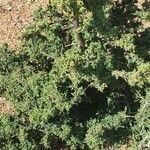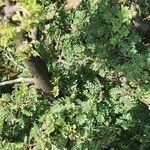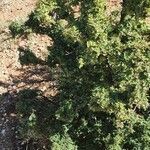Shrub or small tree 1-5 m tall, with white hairs and swollen-based hairs on young stems, leaf rhachis and inflorescence; old stems with fissured corky bark; branchlets often white. Leaves mostly fasciculate; leaflets 7-15, rather thick, 3-11(14?) x 1.5-3.5(6.5?) mm, elliptic-oblong, rounded or retuse and shortly mucronate, rounded or subcordate at the base, the margins flat, pubescent beneath at least on midrib and margins with white hairs, or glabrous, usually densely minutely black-dotted; petiole 2-6 mm long; rhachis 1-3.5 cm long; stipules up to 3 mm long, narrowly triangular, acute, striate. Racemes short, up to 2.5 cm long but often the flowers appearing fascicled, 1-3-flowered; peduncle 0-5 mm long; pedicels 7-20 mm long, with mixed hairs; bracts and bracteoles 2-3 mm long, ovate-lanceolate to lanceolate, the latter 2-4 mm below the receptacle. Calyx usually glabrous except at the margin or sometimes sparsely white-pubescent but always without swollen-based hairs; receptacle cup (hypanthium) 2 mm long; calyx tube 3-5 mm long, the upper lobes 2-3.5 mm long, obtuse, lateral lobes 3-4 mm long, oblong or triangular, sometimes slightly falcate, obtuse, lower lobe 4-6 mm long, triangular, acute. Corolla deciduous; standard cream-coloured or bluish with deep blue-purple venation, the blade 10-14 x 10-17 mm, ovate, truncate or very broadly cuneate at the base, with two protuberances forming an inverted V, the claw 2.5-3 mm long. Stamens diadelphous in 2 bundles of 5. Ovary 5-8-ovulate, densely covered with appressed swollen-based hairs c. 2 mm long. Fruit ± straight or curved, up to 5(6) cm long, all densely covered with stiff yellowish swollen-based hairs up to 7 mm long; stipe 4-7 mm long; articles excluding bristles 8-12 x 6-8 mm, 2 mm thick. Seeds pinkish-brown, compressed, 5 x 3 x 1.2 mm, oblong-ellipsoid.
Leaves mostly fasciculate; leaflets 7–15, rather thick, 3–11(14?) × 1.5–3.5(6.5?) mm, elliptic-oblong, rounded or retuse and shortly mucronate, rounded or subcordate at the base, the margins flat, pubescent beneath at least on midrib and margins with white hairs, or glabrous, usually densely minutely black-dotted; petiole 2–6 mm long; rhachis 1–3.5 cm long; stipules up to 3 mm long, narrowly triangular, acute, striate.
Calyx usually glabrous except at the margin or sometimes sparsely white-pubescent but always without swollen-based hairs; receptacle cup (hypanthium) 2 mm long; calyx tube 3–5 mm long, the upper lobes 2–3.5 mm long, obtuse, lateral lobes 3–4 mm long, oblong or triangular, sometimes slightly falcate, obtuse, lower lobe 4–6 mm long, triangular, acute.
Racemes short, up to 2.5 cm long but often the flowers appearing fascicled, 1–3-flowered; peduncle 0–5 mm long; pedicels 7–20 mm long, with mixed hairs; bracts and bracteoles 2–3 mm long, ovate-lanceolate to lanceolate, the latter 2–4 mm below the receptacle.
Corolla deciduous; standard cream-coloured or bluish with deep blue-purple venation, the blade 10–14 × 10–17 mm, ovate, truncate or very broadly cuneate at the base, with two protuberances forming an inverted V, the claw 2.5–3 mm long.
Fruit ± straight or curved, up to 5(6) cm long, all densely covered with stiff yellowish swollen-based hairs up to 7 mm long; stipe 4–7 mm long; articles excluding bristles 8–12 × 6–8 mm, 2 mm thick.
Shrub or small tree 1–5 m tall, with white hairs and swollen-based hairs on young stems, leaf rhachis and inflorescence; old stems with fissured corky bark; branchlets often white.
A shrub or small tree. It grows 1-5 m tall. It has white hairs. The bark on old stems is cracked and corky. The leaves have 7-15 leaflets. They are 3-11 mm long by 1.5-3.5 mm wide.
Ovary 5–8-ovulate, densely covered with appressed swollen-based hairs c. 2 mm long.
Seeds pinkish-brown, compressed, 5 × 3 × 1.2 mm, oblong-ellipsoid.
Stamens diadelphous in 2 bundles of 5.




